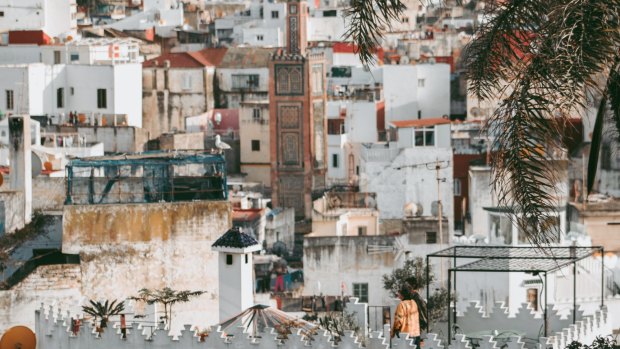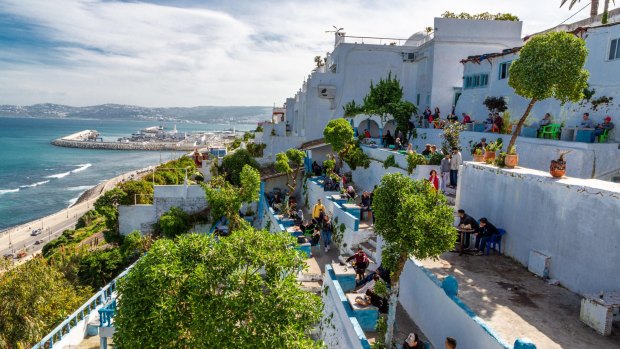This was published 3 years ago
International travel and coronavirus: The one city you should visit when all of this is over
By Ben Groundwater

Tangier: Custom made for travel's dreamers.Credit: Getty
Some cities just have travel in their blood. You can feel their spirit of adventure pulsing through invisible veins in the same way cars fill their streets and people pack their pavements and life roils and bubbles around you.
Tangier has travel in its soul. Tangier is open to the world, curious and experimental. Tangier is the world.
You can reach out and touch it. You can do it at the Gran Café de Paris, with its tuxedoed waiters and its gallery-style seating facing the street, a French custom seamlessly transported. You can feel it at Café Hafa, former hangout for the Beatles and the Rolling Stones, where tiered terraces stare across the Strait of Gibraltar to the shimmering whitewashed villages of Spain.

Café Hafa, a former hangout for the Beatles and the Rolling Stones, where tiered terraces stare across the Strait of Gibraltar.Credit: Alamy
You can understand it at the grave of Ibn Battuta, born 1304, died 1369, a son of Tangier and probably the world's impressive traveller, a man who gazed out to sea in the same way you will and heard the call of the unknown, who spent his life clocking up more countries and almost 10 times more kilometres than Marco Polo himself.
Battuta brought the world back with him to Tangier. It never left.
Here in the far north of Morocco lies a destination that seems custom-made for travel's dreamers, for travel's obsessives. As you sit at home right now in your locked-down life, thinking about future overseas destinations, fantasising about that first big trip back out into the world, this is the place that should be top of your list. This is where you want to go.
I'm not easily bowled over by a destination these days. I know what to expect in most places. But Tangier is different.
The world has come to Tangier because Tangier really was, once, the world. This coastal stronghold has a history as tattered and colourful as a Berber rug: founded by Phoenicians, developed by Carthaginians, conquered by Romans, taken by Byzantines, overpowered by Arabs, fortified by the Portuguese, pinched by the English, attacked by the French, and then given to the world.
Tangier was declared an "international zone" in 1923, an area jointly managed by France, Spain and the UK, though mostly left to its own devices; it became Africa's hub of counterculture, a creative, permissive place where almost anything would go. It drew visits from Jack Kerouac and William S Burroughs, Paul Bowles and Tennessee Williams. Lennon and McCartney called in here. Jagger and Richards hung out.
Though Tangier was eventually subsumed by Morocco in the 1950s, that spirit of envelope-pushing creativity never really left. Admittedly, it went too far for a while. Violence was rife in the 1990s, a period of unrest that won Tangier a bad reputation that has been hard to shake, despite a vast improvement in the city's fortunes.
There's still an edge to the city too, as there is in any border post, particularly one that marks the end of one continent and the beginning of another; the end of one world and the start of a whole new universe. But that's part of Tangier's charm, part of the feeling that the whole world is here, and that it's welcome to make its mark.
It's almost impossible to avoid being seduced by Tangier's past. You're filled with an immediate desire to follow in the footsteps of the artists and beat poets and musicians who were drawn by its spirit, or to take yourself even further back in time. There's Berber history here in the labyrinthine medina; Arabic tradition rife in the tumbledown kasbah.
Any visit to Tangier should begin with coffee at the Gran Café de Paris. Sit outside and watch the hustle of foot traffic, Moroccans dressed in everything from traditional Arabian garb to modern Western fashion. This coffee shop has barely changed in its entire 91 years; including, it seems, most of its staff. How could a place remain so static in a city that's undergone such change?
You sit there and sip strong coffee and contemplate the past and the present. Culture recognisable and then so strange.
Just around the corner is the Grand Hotel Villa de France, where Henri Matisse stayed and painted his "Window at Tangier" in the early 20th century. Nearby is the Cinema Rif, an almost 100-year-old arthouse theatre. The Grand Socco square is a direct transplant from Europe. St Andrews Church provides sanctuary for the city's Anglican population.
But then turn a corner and find a row of local ironworkers who do a side hustle singeing the hair from cow legs for local cooks to then prepare. Walk along the street near the church and you see rows of blackened bovine limbs stacked up outside the shop walls.
Just across from St Andrews, the Marche Sidi Bouabid is a covered market selling pottery and homewares, where locals gather at a tiny shop with no name that sells only bisara, the rib-sticking split-pea soup that should kick-start every day in Tangier. Regular customers have their own bottles of olive oil waiting on the shelf to glug into their soup; loaves of dense, round bread are torn up and dunked. News is swapped. Orders are barked.
Cross the Grand Socco and duck into any doorway or gate and suddenly you're in the Tangier medina, a mind-boggling labyrinth of alleyways and staircases lined with vendors peddling olives and preserved lemons, medjool dates, fruits and vegetables, chickens and lambs and other things you can't identify. Get lost in the medina and it turns into the kasbah, the walled old city, recognisable as the street vendors give way to tall homes huddled over paved pedestrian alleys.
It's a little lazy to say that Tangier's heart lies in the kasbah. Yes, this is the romantic vision of North Africa. The warren of narrow alleys is almost impossible to navigate; kids kick footballs in open squares; artisans sell jewellery and ceramics; hashish smoke wafts from dark windows; women yell to each other from rooftops as they hang out washing; the call to prayer washes over the whole scene multiple times a day.
But the kasbah is just one of Tangier's many vital hubs, just another cog in the city's ever-running machine. And you need to see it all. You need to hear it and feel it and taste it and let it soak into your pores and fill your wandering soul.
Tangier is everything that's great about travel. It is travel. And once this is all over, it's where I want to be.
See also: The 11 destinations Australians should be able to visit in 2021
See also: Fast trains, slow bars: The 11 things from overseas I miss the most
\Which cities, for you, have travel in their veins? Which places best capture the thrill of the experience? Where is the first place you want to go to cure your wanderlust?
Email: b.groundwater@traveller.com.au
Instagram: instagram.com/bengroundwater
LISTEN: Flight of Fancy - the Traveller.com.au podcast
To subscribe to the Traveller.com.au podcast Flight of Fancy on iTunes, click here.
Sign up for the Traveller Deals newsletter
Get exclusive travel deals delivered straight to your inbox. Sign up now.